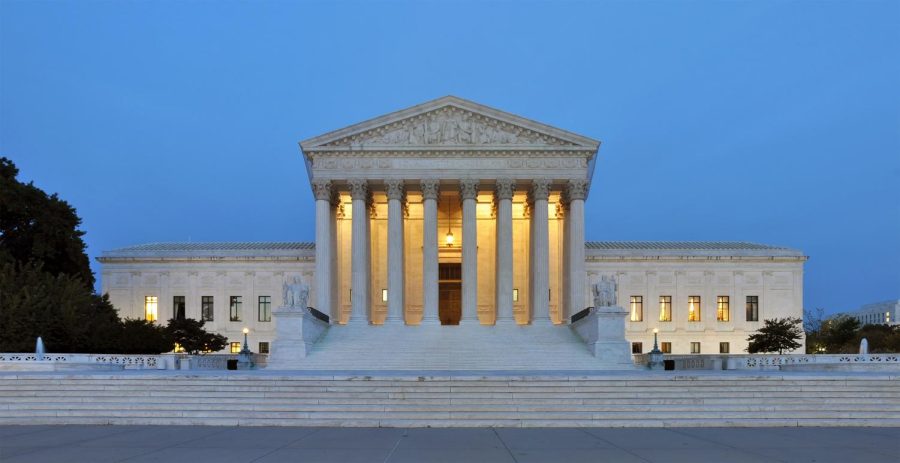Affirmative Action: An Actionable Remedy to Racial Disparity?
Affirmative action is back in the Supreme Court, this time facing the most conservative group of Justices the court has held in the past 90 years.
June 1, 2023
Since colleges and universities began implementing affirmative action in response to the Civil Rights era, the topic has seldom escaped the Supreme Court. Several court cases have consistently approved of the practice in an educational context but have targeted the contentious decision for being a temporary fix to a systemic issue. Currently, the Supreme Court considers affirmative action’s contribution to a more diverse academic environment as a point of protection and upholds the constitutionality of race-conscious admissions.
This year, the decades-long volley match over affirmative action in college admissions awakes once again.
Affirmative action is back in the Supreme Court under two cases: Students for Fair Admissions v. President and Fellows of Harvard and Students for Fair Admissions v. University of North Carolina. Although separate, these two cases aim to overturn the current higher education affirmative action precedent set by the 2003 Supreme Court case Grutter v. Bollinger. Grutter upheld affirmative action so long as race-based decisions remained individualized rather than a quota or points system that explicitly and overtly gave minority students a leg up over their white counterparts.
Students for Fair Admissions aims to constitutionalize the complete eradication of race-conscious admissions decisions.
Students for Fair Admissions v. Harvard contends that Harvard discriminates against their Asian American applicants, while the Students for Fair Admissions v. UNC case argues that UNC discriminates against their white and Asian American applicants, both through their affirmative action policies.
Students for Fair Admissions, a conservative group led by Edward Blum, face a predominantly conservative Supreme Court — the most conservative it has been in the past 90 years. A decision to completely overturn Grutter would drastically impact the future of American higher education campuses.
History of Affirmative Action
Affirmative action is defined as a set of policies designed to favor groups that have been historically marginalized.
The term was first coined in 1961 by President John F. Kennedy when he issued Executive Order (E.O.) 10925 which encouraged employers to hire marginalized people. This order did not include sex or gender in any of its provisions.
In 1965, President Lyndon B. Johnson superseded E.O. 10925 with E.O. 11246, which added sex as a criterion for affirmative action.
In the 1960s and 70s, colleges and universities began adopting affirmative action into their admissions policies. Almost instantly, the battle against race-conscious admission decisions aggressed.
The 1978 Court Case Regents of the University of California v. Bakke established the constitutionality of affirmative action programs in universities. In a divided decision, the court deemed racial quotas unconstitutional but upheld affirmative action policies in admissions for the benefit of a diverse student body.
Since the inaugural affirmative action in higher education Supreme Court case, nine states have banned the practice.
Impacts of Affirmative Action
During the 1996 election, California became the first state to ban racial preferences in college admissions. California voters elected to amend the California Constitution through Proposition 209, which prohibits the state from discriminating against individuals on the basis of “race, sex, color, ethnicity, or national origin” in public employment, public contracting, and public education, effectively banning affirmative action in California public schools.
As a result, these states represent a microcosm of a country where affirmative action is wholly eradicated, and the adverse effects on enrollment rates are transparent.
Despite this, sentiments towards affirmative action stand starkly divided. According to a 2022 Pew Research study, the majority of Americans in every racial/ethnic group are against race-conscious admissions decisions, though this number is highest among white Americans.
Students and staff at Castaic contributed their thoughts amidst the current litigation.
“At the end of the day, they are less qualified,” said Colton Kim, junior, referring to the students affirmative action aims to benefit.
According to a study conducted at Duke University evaluating the effects of Prop 209, the college enrollment rates of African Americans and Hispanics in California’s 4-year public colleges fell “relative to pre-Prop 209 rates and relative to the corresponding rate of whites and Asian Americans.” The average yearly enrollment rates for African Americans fell by 15%, while those for Hispanics fell by 10.3%.
Yet, Hispanic and African American graduation rates improved post-Prop 209 relative to the corresponding rates of whites or Asian Americans. According to the same study, this finding is consistent with “Prop 209 disproportionately reducing the number of less-academically prepared minorities.”
Despite the notable decrease in diverse enrollment rates, many argue that the increased graduation rate of minority students following Prop 209 displays a more efficient sorting of minority students in college admissions.
“University admissions need to prioritize individual accomplishment rather than identity or group politics,” added David Williams, a social science teacher at Castaic.
However, some question if minority students are truly less qualified than their white applicants, or rather placed at a fundamental disadvantage.
“As a student, you cannot control which schools you go to or which teachers you have,” said an anonymous student. “By banning affirmative action, it is more difficult for students to break out of the cycle of having lesser opportunities. At least those students who come from more marginalized backgrounds have a chance.”
In response to this, some argue that affirmative action is more of a bandage than a legitimate solution to systemic racial disparity and that there are more fair workarounds to the root issue.
“The idea of affirmative action is a good idea, it’s a really noble cause, but it doesn’t go about it in the best way possible,” added Kim.
Suggestions from eliminating standardized test scores to looking at other factors outside of race to ensure campus diversity were brought forward.
“Colleges can model the UC, finding workarounds, and maybe using socioeconomic factors, first-gen status, and more outreach programs [to mimic the benefits of race-conscious decisions],” said Daniel Ahn, a government and economics teacher at Castaic.
However, on Aug. 1, UC filed an amicus brief noting that the massive sum of money they have spent on outreach programs to preserve diversity on campus following Prop 209 has failed.
“Although these programs have increased geographic diversity, they have not substantially increased the racial diversity of students admitted to UC, and they have had little impact at the most selective campuses,” reads the brief.
The inefficiency of these programs suggests that race-conscious admissions is an unparalleled approach to directly promoting campus diversity.
“Because these outreach programs primarily target economically and educationally disadvantaged students, the extent to which they are able to reach underrepresented minority students depends on changing demographic patterns,” notes the brief.
“I think perhaps the bigger solution is starting to roll back some of the other admissions guidelines colleges have been doing,” suggested Jonathan Welch, an AP US History teacher at Castaic.
While test-optional policies for the SAT are still young, their effects on improving diversity in colleges appear to be effective. In 2021, Common Application reported that more selective universities recorded over a 20% increase in minority applications after test-optional policies were put into place, suggesting that SAT scores discouraged these students from applying in the first place.
While other foundational approaches to solving racial inequality are the true cure to the lack of diversity on higher education campuses, affirmative action is a direct and actionable remedy to support minorities immediately.
But affirmative action and foundational approaches to equality are not mutually exclusive.
“I think that it’s okay to be used temporarily as long as we’re working towards solving the root problem,” commented another anonymous student, just as the Supreme Court Justices have ruled in the past.
And until fundamental educational equality is reached, legacy admissions and nepotism prevail and predominantly benefit white people, perpetuating a skewed playing field.
Legacy Admissions
In Nov. 2022, Justices on both sides of the affirmative action debate brought up legacy admissions.
“A university can take into account and value all of the other background and personal characteristics of other applicants, but they can’t value race,” said Justice Ketanji Brown Jackson. “That seems to me to have the potential of causing more of an equal protection problem than it’s actually solving.”
While affirmative action has been plaguing the headlines, the fate of legacy admissions may rest at the hands of the Supreme Court as well.
“…I don’t know how any college president or Board of Trustees member can possibly preserve legacy preferences if the court tells colleges they can no longer consider the race of an applicant. Shame alone will make it necessary to drop legacy preferences,” remarked James Murphy, a senior policy analyst who wrote a report on the court session.
And some would agree, believing that drawing the line at one means drawing the line at both.
“They’re both valid as long as they are balanced, you cannot have too much of one or the other,” said Dunstan Joseph Leogo, junior.
“Both are inherently making selections not solely on qualifications, so my stance is I think we should reject both,” opposed Kim.
Like affirmative action, legacy admissions is popularly disliked. 75 percent of Americans and 89 percent of college admissions directors disagree with the use of legacy status in admissions decisions.
Others, however, believe there are valid arguments to accept one while rejecting the other.
“If we’re looking at affirmative action we’re looking at it from a place of opportunity, and with the legacy admissions you’re almost just taking that opportunity away,” said Welch.
A 2007 study of 30 highly selective colleges revealed that a legacy status made applicants three times more likely to be admitted than their non-legacy counterparts. At Harvard, this disparity was reported to be a difference of sixfold.
“It’s keeping the rich richer and keeping the poor poorer,” remarked an anonymous student when asked about legacy admissions.
Duke University’s president, Vincent Price, defends legacy as a way to find “students [who] will thrive.” However, Duke’s first Black student was enrolled in 1963. When referring to thriving students, Price is also inadvertently referring to almost exclusively white students.
Ultimately, the question of affirmative action cannot be evaluated without bringing legacy admissions into the spotlight.
While both admissions strategies take into account an uncontrollable factor, the morality and benefits of each must be leveraged by the Supreme Court and admissions committees to establish a new precedent.



